Merlin XX restoration
This will follow the restoration of a Merlin MK XX to
static running condition. We hope to give our customers and visitors an insight
into the challenge and rewards of such a project. The information is kindly
being supplied by Dave who is the owner of this beautiful Mk XX and he gets our
grateful thanks for sparing the time to share his project with us.
Updates will be listed in
"What's New"
Updated 17/11/09
Welcome to this page which Graham has kindly put together
for anyone interested in following my restoration of this Merlin XX engine. I
bought the engine just before Christmas 2007. There are a number of people, all
of whom have played a big part in enabling me to do this, and if any of you read
this (you know who you are!), I would like to say a huge thank you.
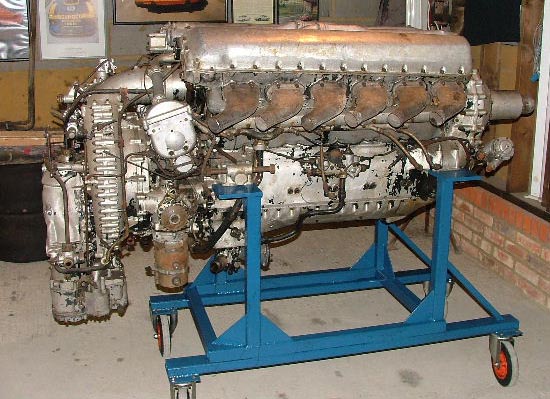
I have tried to trace as much history as possible about the engine in the short
time I have had it. The only definite information so far has come from the Rolls
Royce Heritage Trust who have been very helpful with information and advice. The
engine was one of 2000 built at the Rolls Royce factory in Glasgow to contract
number SB4601/40 between 9th January 1942 and 1st June 1942. This particular
engine 52771, was built in the week ending 23rd Jan 1942 and was despatched on
7th Feb 1942. Beyond that the only additional information was 'believed written
off in Russia' and that it was probably installed in a Hurricane II. Certainly
the Hurricane link is likely as the engine has upper coolant galleries for a
header tank mounted behind the engine, and a chain sprocket for manual starting,
both features that I think were unique to the Hurricane installation. Beyond
this, most of the information is very uncertain, but it does seem likely that it
was recovered from Russia at some stage, and there are conflicting reports
that suggest it could have been connected in some way with three different
Hurricane airframes. I would be extremely grateful if anyone has any more
information that Graham could pass on to me.
This will be a huge learning curve, but the intention is to try and restore this
engine to running condition. Clearly this will depend largely on what we find
once it starts coming apart, but one thing is for sure, this will be a long term
project, not least of all because I need to move house before making a start!
So, it could be a while before it gets under way, but hopefully the photos will
be worth the wait.
Enjoy Dave
The Merlin XX
ran on 100 octane fuel. This allowed it to be run at higher
manifold pressures, which were achieved by increasing the "boost" from the
centrifugal type supercharger. The result was that the otherwise similar engine
delivered 1,300 hp (970 kW). Another improvement made to the XX and future
Merlin variants was a redesign of the cooling system to work using a 70/30%
water/glycol mix rather than the 100% glycol of the Merlin I, II and III series.
This allowed the engines to run some 70 degrees C cooler, substantially
improving engine life and reliability. This also removed a potential fire hazard
from Merlin powered aircraft, as pure ethylene-glycol is a flammable liquid.
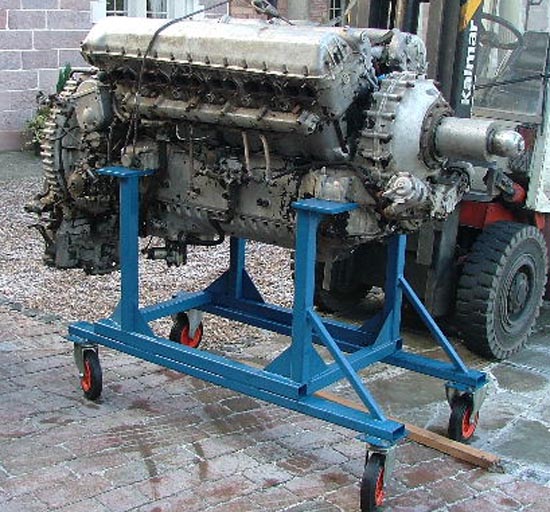
The Merlin XX
cutaway

Updated 11th December 2008
Well, it's a start! The engine is still quite inaccessible
at the moment, but I did manage to take off one cam cover.
It appears to be quite good inside (so far!).
The cam, rockers and bearing brackets etc are all well
preserved. The only items of concern at this stage are the valve springs as they
are heavily pitted with corrosion, so I would certainly not be happy to use them
if all goes well and it is still built to run.
Hopefully the engine will be moved to a clear area soon,
so then I will be able to really see how well the rest of the engine has
survived.
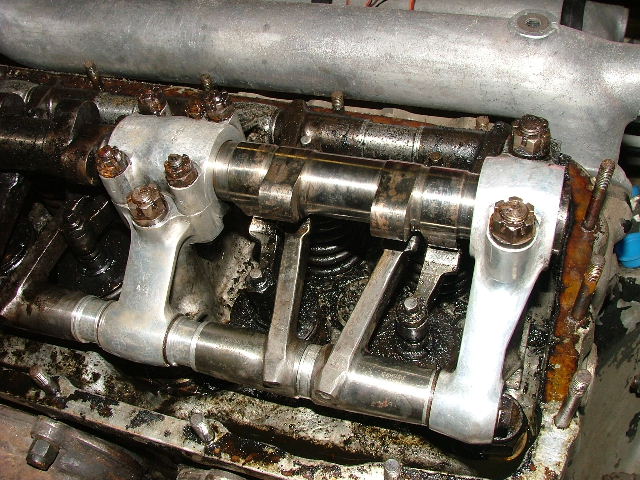
The aim is to break the engine down into main sections,
cylinder blocks, reduction gear, carb and supercharger etc.
There is a crack in the main crankcase casting by one of
the rear engine mountings so I want to get the crankcase fully stripped so that
it can be repaired.
Then, starting with the overhauled crankcase, hopefully it
will be a case of restoring each item as it is needed to put the engine back
together. Makes it sound easy!!!
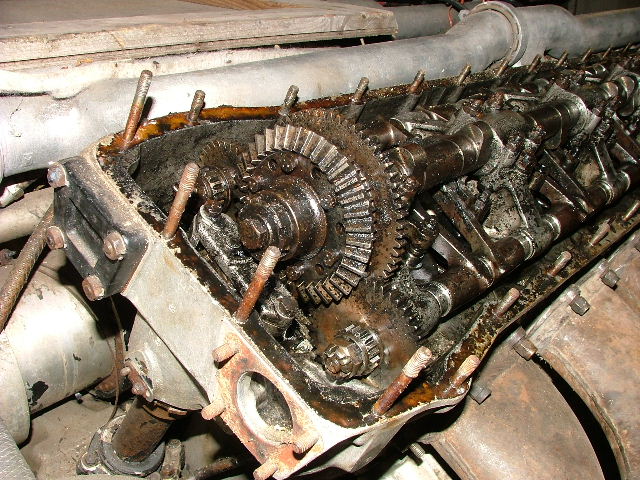
Updated 17/11/09
At last, there's been some more progress with the Merlin.
While I was waiting to move the engine to a bigger space, I got stuck in to
overhauling the ignition harnesses. This proved to be a much more intensive job
than I expected, largely due to the fact that so much of the original exhaust
harness was damaged or missing. I'm very grateful to all those who helped to
provide all the bits and pieces that I needed to complete the task. The picture
shows the completed exhaust harness, and the inlet one is now finished too.
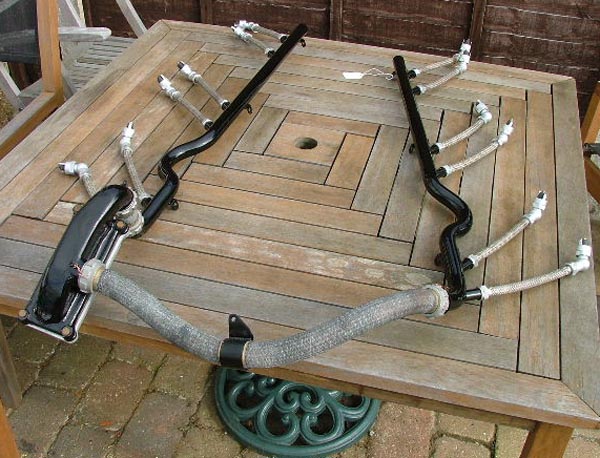
I began the strip down of the engine by removing the V-drive and reduction gear.
As I broke the seal between the reduction gear case and crankcase, a
considerable quantity of water drained out. I suddenly had images in my mind of
the pinion being a pile of rust at the bottom of the casing! Thankfully it
proved not to be the case at all. As can be seen in the picture, the condition
appears to be remarkably good given the length of time that the engine has been
sitting idle (about 65 years!).

Since then I have removed the camshaft assemblies, carb and supercharger, and
most of the 'bits and pieces', like pipe work, exhaust stubs, coolant galleries,
magnetos, fuel pump and generator bracket. The engine is looking quite bare now,
and much smaller (relatively speaking!). The next step will be to remove the
wheelcase. At that stage it is time to lift the one-piece blocks off, and
finally see if the cylinder bores have survived.
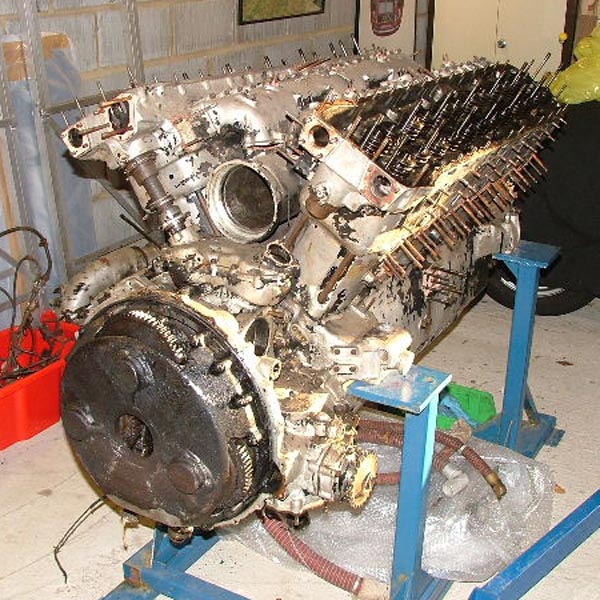
It is remarkable that given the several hundred nuts, bolts and lock rings that
have so far been undone, not a single fastener has been seized or failed to
undo, even though most nuts were corroded beyond recognition. A fraction of a
turn with small vice-grips and they all wound off by hand. So far, I have about
2,500 new nuts and washers ready for the reassembly. This only covers the
bolting together of the main components! Thank goodness for e-Bay and the
internet.
|
